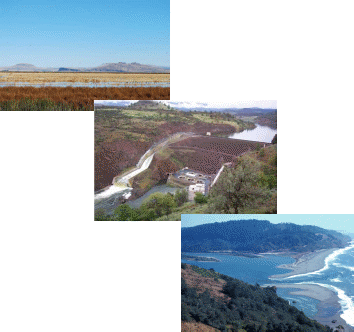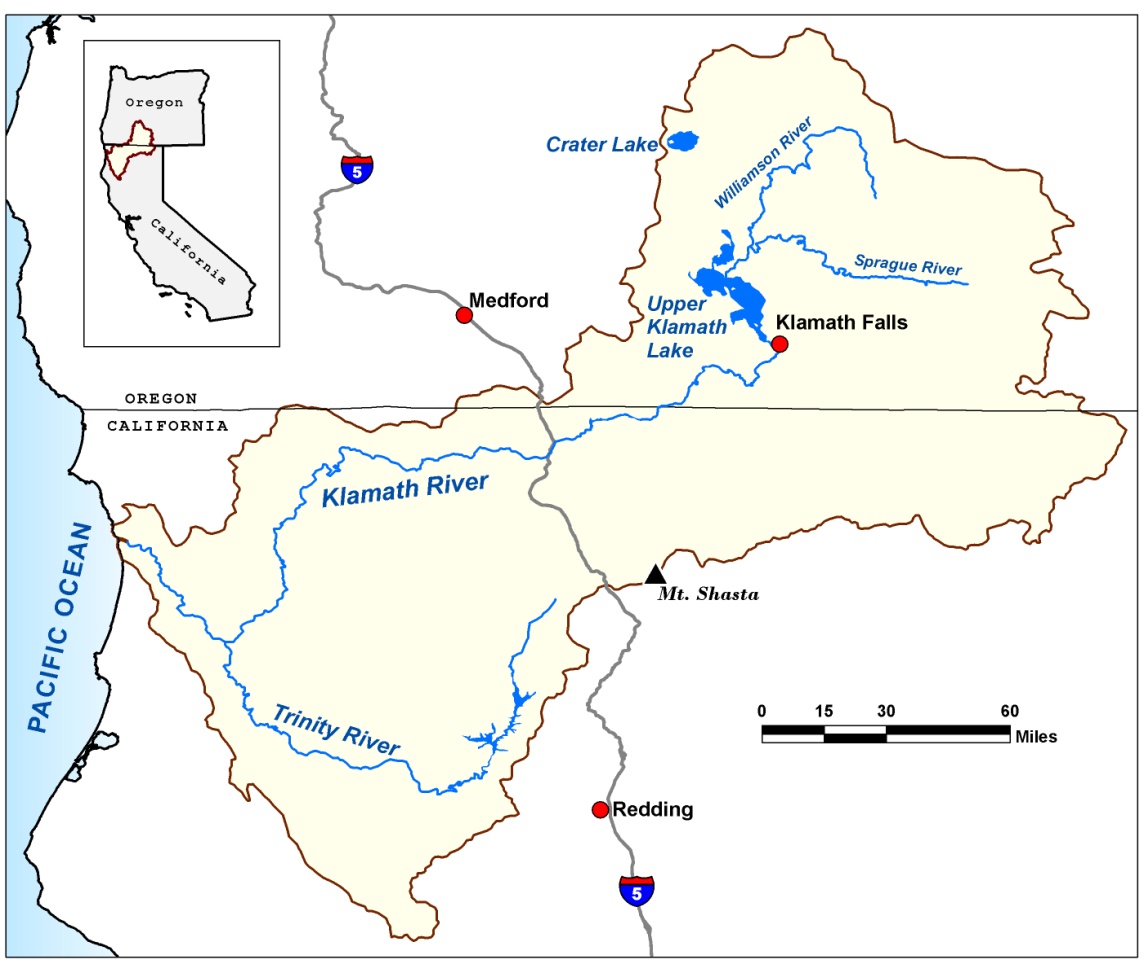Shortened Klamath Nonuse Valuation Survey
Klamath Non-use Valuation Survey
Short survey Instrument
Nonresponse bias sample mailing respondents (households with telephone numbers)
OMB: 1090-0010
Restoring a U.S. River Basin: What Is Your Opinion?
Across the United States, many river systems are under stress from population growth, pollution, and competing demands for water. This survey focuses on one river system in particular: the Klamath River Basin.
The federal government is considering plans for restoring this river basin and its fish populations. Understanding the views of households like yours will help the government choose the best option.

Upper
Klamath Basin (Oregon)
Iron Gate Dam on the
Klamath
River
Klamath River Estuary at the
Pacific
Ocean (California)
Your participation in this survey is voluntary. The reports prepared for this study will summarize findings across the sample and will not associate responses with a specific individual. We will not provide information that identifies you to anyone outside the study team, except as required by law. Your responses will be stored separately from your name and address, and when analysis of the questionnaire is completed, all name and address files will be destroyed.
A Federal agency may not conduct or sponsor, and a person is not required to respond to, a collection of information unless it displays a currently valid OMB control number.
Burden estimate statement: Public reporting for this form is estimated to average 30 minutes per response. Direct comments regarding the burden estimate or any other aspect of this form to:
Ben Simon, MS3530-MIB, 1849 C Street N.W., Washington, DC 20240 or [email protected].
OMB Control #1090-0010
Expiration Date:
Cover photos courtesy of the U.S. Fish and Wildlife Service (FWS)
About the Klamath River Basin
The basin occupies over 10 million acres (the yellow area in the map). It is twice the size of Massachusetts. About 120,000 people live in the basin, including 16,000 members of Indian tribes. Klamath Falls, Oregon, is the largest city, with a population of roughly 20,000.

Before you started this survey, had you ever heard of the Klamath River Basin?
Yes
No
I don’t know
Have you ever visited the Klamath River Basin?
Yes
No
I don’t know
How many recreation trips did you make to the Klamath River Basin in the past 12 months?
______ trips
Competing Demands for Klamath River Basin Water
People use the water in the basin in many ways. Like other big rivers, it is difficult to balance how much water should go to each different activity. Some of the main uses of the Klamath River and its tributaries are.
Farmland irrigation.
Hydroelectric power.
Commercial fishing..
Recreation and tourism.
Tribal cultural practices.
The Klamath River Basin is important for many groups, but there is not always enough water for everyone, especially in drought years. Competing demands for water have been a source of conflict in the basin.
The River Basin Restoration Plan
The federal government must decide whether to support a plan that would remove several hydroelectric dams on the Klamath River and change the way water is managed in the basin. The main features of the plan are:
Remove four large hydroelectric dams from the Klamath River in 2020. The reservoirs created by these dams (each 4 to 7 miles long) would no longer exist after 2020.
Fish habitat also needs to be further improved. So, the plan would fund projects to restore fish habitats in the basin.
Together with removing the dams, the projects will increase the number of wild salmon and trout throughout the basin, reduce the chances of extinction for some fish species, and improve water quality in the Klamath River.
The plan sets a permanent, annual schedule for water deliveries to farms and for water releases to the river.
The plan will reduce uncertainty over water sharing and avoid future conflict and lawsuits among tribes, farmers, fishermen, and other parties, which cost the public many millions of dollars
The agreement would also
Cost many millions of dollars to
Deconstruct and remove the dams, to replace the dams’ energy, to restore fish habitat, improve water quality, and encourage farmers to use less water;
Release the sediment behind the dams into the Klamath River during dam removal, which would affect fish and water quality for 1–2 years;
Eliminate recreational activities supported by the dams; about 100 homes now located near the shores of the reservoirs would lose their lakefront view.
Q4. People often have different views about plans like this one. Please rate how much you agree or disagree with each of the following statements. (Circle the number that matches your answer. If you have no opinion, check the box in the No Opinion column.)
|
1 |
2 |
3 |
4 |
5 |
No Opinion |
Some decrease in environmental quality is inevitable if we are going to continue to improve our standard of living |
1 |
2 |
3 |
4 |
5 |
|
When humans interfere with nature, it often produces disastrous results |
1 |
2 |
3 |
4 |
5 |
|
Humans should modify the natural environment to suit their needs |
1 |
2 |
3 |
4 |
5 |
|
The balance of nature is very delicate and easily upset |
1 |
2 |
3 |
4 |
5 |
|
The decision to develop natural resources should be based more on economic grounds than on environmental grounds |
1 |
2 |
3 |
4 |
5 |
|
It is important to use rivers as a source of electric power |
1 |
2 |
3 |
4 |
5 |
|
It is important for rivers to provide places for recreation |
1 |
2 |
3 |
4 |
5 |
|
It is important for rivers to provide healthy habitat for fish |
1 |
2 |
3 |
4 |
5 |
|
It is important to use rivers as a source of water for irrigation |
1 |
2 |
3 |
4 |
5 |
|
It is important for rivers to provide Indian tribes with traditional fishing areas |
1 |
2 |
3 |
4 |
5 |
|
It is important for rivers to support commercial fishing |
1 |
2 |
3 |
4 |
5 |
|
About You and Your Household
Finally, we would like to ask you a few questions about you and your household. These questions will be used to compare our survey respondents with the U.S. population as a whole. Your answers will be kept anonymous. They will not be saved or stored in a way that can be associated with your name or address.
Are you male or female?
Male
Female
What is your age?
_________ years old
What is your is your current marital status?
Single, never married
Married or living with a long-term partner
Separated or divorced
Widowed
How many children under age 18 are living at your home?
____________ children
What is the highest degree or level of school you have completed?
No high school diploma
High school diploma or GED
Some college credit or college degree
Some graduate school or professional school credit or a graduate or professional degree
Thank you very much for your help.
| File Type | application/vnd.openxmlformats-officedocument.wordprocessingml.document |
| Author | carolm |
| File Modified | 0000-00-00 |
| File Created | 2021-02-01 |
© 2026 OMB.report | Privacy Policy